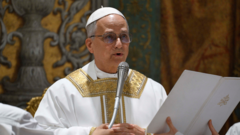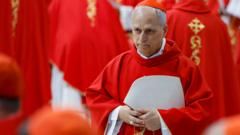Cardinals in Vatican City face delays in electing a new pope, signaling complex dynamics among the convent participants.
Live Updates: No New Pope as Black Smoke Signals Inconclusive Voting

Live Updates: No New Pope as Black Smoke Signals Inconclusive Voting
The Vatican conclave continues as cardinals gather for further votes after morning's black smoke.
Black smoke billowed from the chimney of the Sistine Chapel on Thursday morning, indicating that the cardinals could not reach a consensus on the election of a new pope during their first round of voting on the second day of the conclave. The event took place in front of a crowd gathered anxiously in St. Peter’s Square, awaiting the decisive white smoke that signifies a new pontiff.
The conclave, which convened following the death of Pope Francis last month, is shaping up to be an intense and potentially prolonged conflict due to the diverse backgrounds of the 133 participating cardinals, many of whom were appointed by the late pope himself. With preliminary voting results having been inconclusive, expectations linger about whether a candidate can secure the necessary two-thirds majority.
The morning session of voting resulted in gasps and murmurs of disappointment from onlookers as the black smoke emerged, suggesting that the ballots had been counted and no clear winner was established. Following a lengthy first voting that lasted over three hours, the cardinals are set to reconvene after a break for lunch, with hopes that subsequent rounds of voting might yield a more favorable outcome.
The cardinals will conduct a series of votes throughout the day until they reach a suitable candidate. The tradition of burning ballots has been a part of the papal election process, with black smoke indicating failure to elect a pope and white smoke confirming a successful election.
Given the size and diversity of the cardinal assembly, speculation surrounds the nature of the conclave’s discussions. Cardinal Timothy Dolan of New York has suggested that the duration of this conclave may prolong, as many cardinals are unfamiliar with one another, creating a more complex decision-making process.
For many, this election serves as a referendum on the legacy of Pope Francis and the direction the church should take moving forward. While some aspire to maintain the progressivism championed by Francis, others push for a return to traditional values, reflecting deep ideological divisions within the church.
Enthusiasm from the gathered crowds is palpable, with international observers eager to witness history as they anticipate new developments. As the cardinals once again prepare to cast their votes, the world watches closely, awaiting the predicted shifts in ecclesiastical leadership.
The conclave, which convened following the death of Pope Francis last month, is shaping up to be an intense and potentially prolonged conflict due to the diverse backgrounds of the 133 participating cardinals, many of whom were appointed by the late pope himself. With preliminary voting results having been inconclusive, expectations linger about whether a candidate can secure the necessary two-thirds majority.
The morning session of voting resulted in gasps and murmurs of disappointment from onlookers as the black smoke emerged, suggesting that the ballots had been counted and no clear winner was established. Following a lengthy first voting that lasted over three hours, the cardinals are set to reconvene after a break for lunch, with hopes that subsequent rounds of voting might yield a more favorable outcome.
The cardinals will conduct a series of votes throughout the day until they reach a suitable candidate. The tradition of burning ballots has been a part of the papal election process, with black smoke indicating failure to elect a pope and white smoke confirming a successful election.
Given the size and diversity of the cardinal assembly, speculation surrounds the nature of the conclave’s discussions. Cardinal Timothy Dolan of New York has suggested that the duration of this conclave may prolong, as many cardinals are unfamiliar with one another, creating a more complex decision-making process.
For many, this election serves as a referendum on the legacy of Pope Francis and the direction the church should take moving forward. While some aspire to maintain the progressivism championed by Francis, others push for a return to traditional values, reflecting deep ideological divisions within the church.
Enthusiasm from the gathered crowds is palpable, with international observers eager to witness history as they anticipate new developments. As the cardinals once again prepare to cast their votes, the world watches closely, awaiting the predicted shifts in ecclesiastical leadership.




















